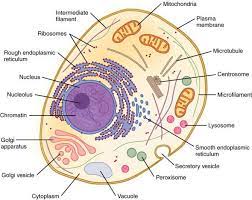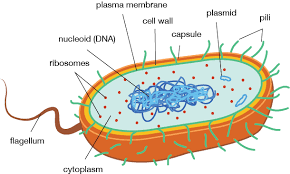Note
0.0(0)
Explore Top Notes Note
Note Studied by 41 people
Studied by 41 people Note
Note Studied by 509 people
Studied by 509 people Note
Note Studied by 32 people
Studied by 32 people Note
Note Studied by 8394 people
Studied by 8394 people Note
Note Studied by 302 people
Studied by 302 people Note
Note Studied by 47 people
Studied by 47 people
Hygiene - A Key to Healthy Life
5.0(2)
AP Psychology - Development
5.0(2)
Personality 210 Psychology Notes (Part 4) The Big Five
5.0(1)
Unit 2: Differentiation: Definition and Fundamental Properties
5.0(11)
Unit 7: Period 7: 1890-1945
5.0(1)
Chapter 17 - The Civil War
5.0(1)
Prokaryotes and eukaryotes
Eukaryotic cell structure

}}Nucleus}}
- Nucleus = surrounded by double membrane called the nuclear envelope
- Nucleus = Contains nuclear pores to allow molecules to enter and leave
- Nucleus = Contains chromatin and a nucleolus (where ribosomes are produced)
}}Rough endoplasmic reticulum}}
- RER = series of flattened sacs enclosed by a membrane with ribosomes on the surface
- RER = It folds and processes proteins made by ribosomes
}}Smooth endoplasmic reticulum}}
- SER = series of membrane bound sacs
- SER It synthesise and processes lipids and steroids
}}Golgi apparatus}}
- Golgi = stacked fluid filled, flattened and curved sacks called cisternae
- Golgi = Has vesicles surrounding the edges
- Golgi = Sorts, processes and packages proteins and lipids
- Golgi = Produces lysosomes
- Golgi = Also modifies proteins into lipo/glycoproteins
}}Centrioles}}
- Centrioles = hollow cylinders containing a ring of micro tubules arranged in a 9+2 arrangement
- Centrioles = Involved in cell division (pull chromosomes apart from the equator)
}}80s ribosomes}}
- 80s ribosomes = composed of a large 60s subunit and a small 40s subunit
- 80s ribosomes = Where protein synthesis occurs
}}Lysosomes}}
- Lysosomes = vesicles containing digestive enzymes
- Lysosomes = Bound by a single membrane
}}Mitochondria}}
Mitochondria = bound by a double membrane called the envelope
Mitochondria = Inner membrane is folded into cristae
Mitochondria = Has a matrix on the inside containing enzymes needed for aerobic respiration
Prokaryotic cell structure

<<Cell wall<<
- Cell wall = ridged outer covering made of peptidoglycan
- Cell wall = Provides cell with support and strength
<<Slime capsule<<
- Capsule = protective slime layer which helps cells retain moisture
- Capsule = Helps adhere to surfaces
<<Plasmid<<
- Plasmid = circular piece of extra DNA
<<Flagellum<<
- Flagellum = tail like structure that rotates to move the cell
<<Pili<<
- Pili - hair like structures which attach to other bacterial cells
- Allow plasmids to move from cell to cell
<<70s ribosomes<<
- 70s ribosomes = composed of a large 50s subunit and small 30s subunit
- 70s ribosomes = Site of protein synthesis
- 70s ribosomes = Smaller than the eukaryotic ribosomes
<<Mesosomes (artefact)<<
- Mesosomes = in folding of the inner membrane which contain enzymes needed for respiration
Bacterial cell wall
bacteria can be classified according to their shape and their reaction to gram stain
Gram positive
- cell wall made of a thick layer of peptidoglycan, and an inner plasma membrane (phospholipid bilayer)
- Will stain violet after having gram stain put on it as the crystal violet stain binds to the peptidoglycan cell wall
Gram negative
- cell wall made of a thin layer of peptidoglycan with an outer lipopolysaccharide membrane and an inner phospholipid bilayer
- Wont stain with gram stain as the peptidoglycan isn’t available to bind to
- Will stain pink after washing with ethanol and using red Safranin
Bacteria and medication
- different antibiotics are needed for gram positive and gram negative bacteria
- Gram positive bacteria release exotoxins whilst alive and make you feel ill quicker
- Gram negative bacteria release endotoxins when dead and make you feel ill after a while
Note
0.0(0)
Explore Top Notes Note
Note Studied by 41 people
Studied by 41 people Note
Note Studied by 509 people
Studied by 509 people Note
Note Studied by 32 people
Studied by 32 people Note
Note Studied by 8394 people
Studied by 8394 people Note
Note Studied by 302 people
Studied by 302 people Note
Note Studied by 47 people
Studied by 47 people
Hygiene - A Key to Healthy Life
5.0(2)
AP Psychology - Development
5.0(2)
Personality 210 Psychology Notes (Part 4) The Big Five
5.0(1)
Unit 2: Differentiation: Definition and Fundamental Properties
5.0(11)
Unit 7: Period 7: 1890-1945
5.0(1)
Chapter 17 - The Civil War
5.0(1)